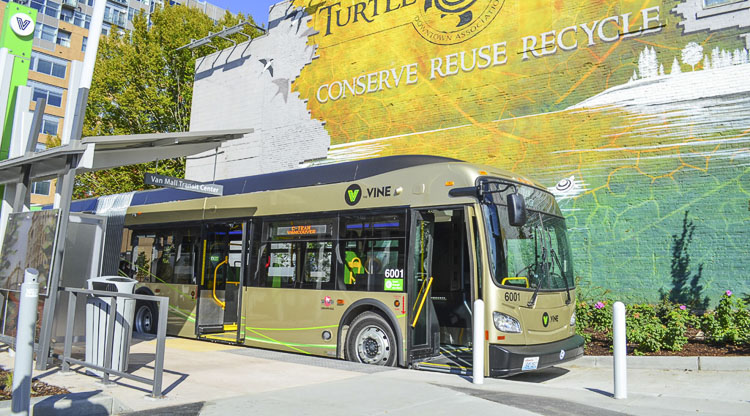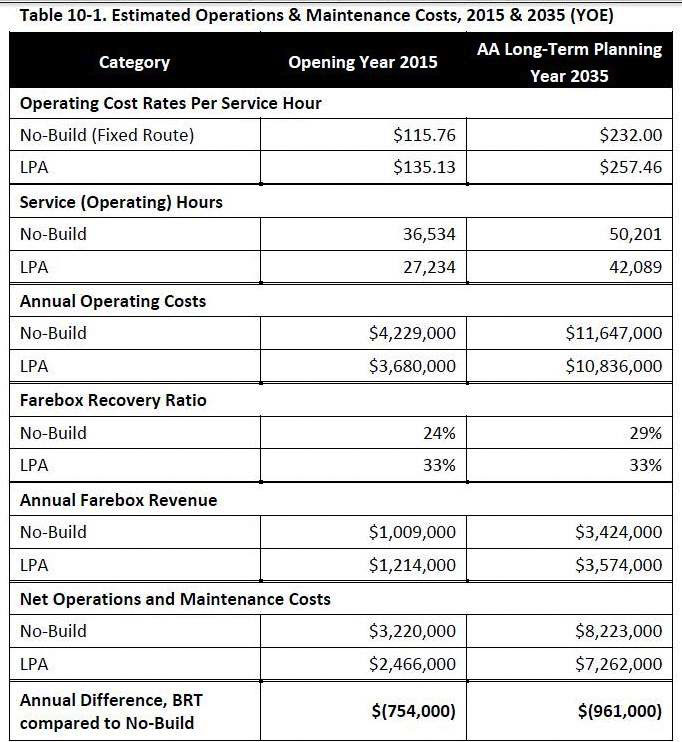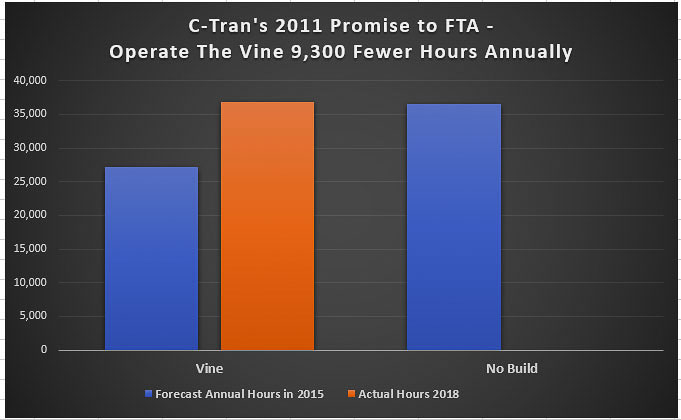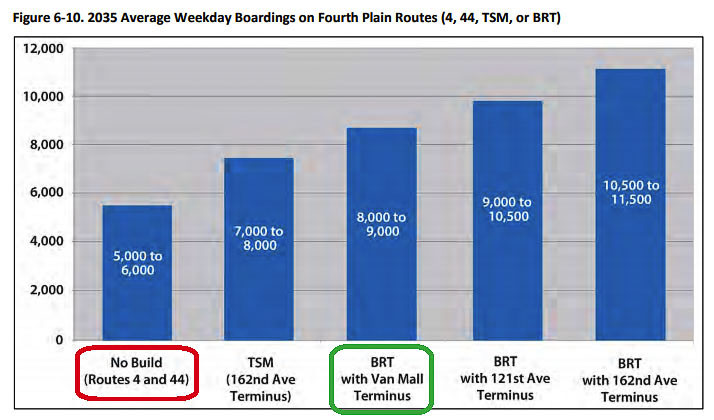A 25 percent reduction in hours of operation never materialized in running more expensive BRT
As C-TRAN celebrates 40 years of serving Clark County citizens, the $53 million Bus Rapid Transit (BRT), known as The Vine, is three and a half years old. C-TRAN has received funding to move forward with its second BRT line on Mill Plain where service is scheduled to begin in 2023.
Approximately 85 percent of C-TRAN’s operating costs are paid with Clark County citizens sales tax revenues, according to C-TRAN. Passenger fares make up about 15 percent of operating costs.
The Vine was supposed to save C-TRAN $754,000 in its first year. Has The Vine saved C-TRAN and taxpayers $2.6 million so far compared to running their regular bus service the first three and a half years of service?
In 2012, C-TRAN informed citizens about the various “options” for the BRT along the Fourth Plain corridor. Included in the formal evaluation (alternatives analysis) were four options for routing, and a “No Build” option. Officials said the Locally Preferred Alternative (LPA) would end at the Vancouver Mall and save taxpayers $754,000 in 2015 and the savings would increase to $961,000 in 2035.

The plan was to eliminate regular bus service on C-TRAN routes #4 and #44, both of which traveled Fourth Plain from the Vancouver Mall to downtown. Route #44 began in the Battle Ground area, before traveling to the Vancouver Mall. The BRT service would still travel in regular vehicle lanes, but would have priority at stop lights along the way to help it be more “rapid.”
In their 2011 application to the Federal Transportation Administration (FTA), C-TRAN officials said their BRT line would cost $135.13 per hour of operation (2015) whereas the hourly cost of the “no build” running existing buses would cost $115.76 per hour. How did more expensive hourly service “save” $754,000 annually?
By running fewer hours a year. C-TRAN specifically planned a 25 percent reduction in BRT operating hours — 9,300 fewer in 2015. When The Vine was up and running, they actually operated at the same number of hours as the “no build” option — over 36,000 annual hours in the first three years of operations versus the “promised” 27,234 hours.
Using the 2011 hourly cost estimates, it would appear that The Vine actually cost about $739,000 more than the “no build” option instead of saving $754,000. There were no savings to operate The Vine’s more expensive articulated $1.1 million buses. After three and a half years of operations, BRT could have increased C-TRAN’s costs by $2.5 million. But C-TRAN doesn’t track The Vine costs separately.
C-TRAN CEO Shawn Donaghy was asked the following by Clark County Today.
“When C-Tran asked the citizens and the FTA for federal funding in 2011, they said BRT would save C-Tran $754,000 in its first year of operations. Did it save that much money on The Vine in 2017?
Will the Mill Plain BRT line, once open, save us money? If so, how much?”
Donaghy has not responded at the time of this report.
Furthermore, C-TRAN officials promised citizens and the FTA that BRT passenger fares would cover a higher percentage of operating costs than the “no build” option — 33 percent versus 24 percent. The higher farebox recovery ratio was supposed to contribute $205,000 to the promised $754,000 savings.
The reality appears to be far different. In 2017, C-TRAN’s farebox recovery systemwide had declined to 17.2 percent, the first year The Vine operated. The decline continued in 2018 to 15.9 percent for the Vine and 14.3 percent for the entire fixed route system. Farebox recovery peaked in 2011 and has dropped every year since 2013.

On page 190 of the 191 page alternatives analysis, C-TRAN showed the bottom line numbers. Hourly operating costs were $115 per hour for regular bus service and $135 per hour for BRT. The BRT would be operated 25 percent fewer hours than the two bus routes (#4 & #44) to be eliminated, and would also capture better fares for a higher farebox recovery rate of 33 percent versus 24 percent in 2015.
Over a 20-year period, the BRT costs would save $16 million compared to the regular bus service C-TRAN promised.
BRT Savings
The alternatives analysis indicates BRT will run 25 percent fewer hours annually; (27,234 vs. 36,534 hours). C-TRAN explained.
“Operating hours for 2015 opening year were estimated using existing service (No-Build), and applying travel time and dwell time reductions based on research to estimate BRT annual service hours. Travel time reductions are compared to the No-Build alternative, and were estimated by researching travel time savings realized with similar transit and BRT treatments elsewhere in the United States for the LPA’s major components, including implementing Transit Signal Priority along the Fourth Plain Boulevard route (not available in the No-Build Alternative), level boarding and wheelchair-user self-securement, off-board fare collection, on-board bicycle parking, and BRT buses having multiple doors for boarding and alighting.”
Additionally, C-TRAN said “The LPA would reduce the Fourth Plain corridor’s share of system-wide O&M costs from 9% to 8% in the 2015 Opening Year.”
They predicted “Also included were revenue projections including a proposed 0.1% sales tax increase for High Capacity Transit under RCW 81.104.” Furthermore, they “included in the three economic scenarios in the YOE (year of expenditure) analysis were cost inflation, construction cost indexing, population (and thus ridership) growth assumptions, as well as revenue assumptions based on historical trends.”
Contingencies totaling approximately 25 percent of the estimated costs were added to the various project elements, along with an annual inflation rate of 3.5 percent.
The LPA promised 10-minute frequency of BRT service during peak hours and every 15 minutes off peak. Additionally, “analysis has shown that BRT can be operated along the corridor with fewer buses than what C-TRAN is currently operating on the corridor.”
The cost per hour of operation was stated as $115.76 per hour for regular bus service and $135.13 (2015) for BRT. How then could they say the BRT would save money?
They reported BRT “increases transit ridership: the LPA is projected to attract the highest number of new transit riders of any alternative, both in opening year and by 2035. The increase is substantial enough to help constrain growth in traffic congestion levels along the Fourth Plain corridor.”
Did The Vine actually increase ridership compared to 2011? In a word, the answer would appear to be no.
C-TRAN officials told the Federal Transit Administration in 2011 they served over 6,000 average weekday passengers” and forecast between 8,000 and 9,000 people served by 2035. Yet in 2019, (prior to the pandemic), average weekly boarding passengers were down by over 33 percent, to 3,989.

Yet C-TRAN said “the LPA is the most cost effective alternative. Operating costs for the corridor will be reduced compared to existing (no-build) conditions and lower than the TSM (transportation systems management) alternative. Operating cost per boarding passenger would be approximately half of existing costs.”
In 2019, The Vine operated service for 36,826 hours. That is 35 percent more hours than C-TRAN officials told the FTA and area residents. The cost savings of $754,000 estimate was based on operating the more expensive Vine BRT at just 27,234 hours.
Using the 2019 operating hours for the 2012 comparison, The Vine BRT “alternative” would have been $739,000 more expensive than the “No Build” alternative.
Farebox recovery
The alternatives analysis also predicted, incorrectly, that passenger fares would increase, ultimately rising from 24 percent in 2015 to 29 percent in 2035. Instead, passenger fares only cover 15 percent of operating costs in 2019, moving in the opposite direction of C-TRAN’s forecast.
Additionally, the analysis predicted BRT passenger fares would cover 33 percent of operating costs, both in 2015 and 2035. C-TRAN reports The Vine collects just 17.5 percent of operating costs in 2019. Once again, C-TRAN made rosy predictions for increased farebox revenue collections and instead passenger fares have covered less and less operating costs.
On the first anniversary of The Vine, C-TRAN published a flyer celebrating its success. The first bullet point said the following.
Cost-effectively increase transit ridership
• 45% increase in ridership
• 27% increase in passengers per hour
• 21% decrease in operating cost per passenger boarding
C-TRAN officials explained the 21 percent decrease in operating cost per passenger this way. They used an average of all fixed route operating costs of $125 per hour. “C‐TRAN does not currently track financial data at an individual route level. Net Operating Cost and Operating Revenue used in the table are estimates based on the average financial data for C‐TRAN’s full Fixed Route Service.”

The Vine operated 3,020.5 hours of revenue service (each month) according to C-TRAN, whereas route #4 would have operated 2,643.2 hours — 14 percent more BRT hours. This is likely due to the promised service of every 10 minutes versus the 15 minute service on route #4.
The Vine carried 102,719 (monthly) passengers its first year versus an “average” of 70,845 for route #4, leading C-TRAN to show the numbers for the 45-percent increase in ridership used in the 1st anniversary flyer.
However in a different public records response, C-TRAN reported 2016 total route #4 boardings of 1,259,385, and 4,919 on an average week day. The increase comes from using 2016 numbers instead of the 2011 numbers provided to the C-TRAN Board of Directors for approving the project, and also sent to the FTA.
C-TRAN officials were able to break out unique hourly cost estimates for BRT versus their regular bus service in their 2011 request for federal funding. Yet once they received that funding they have chosen to not keep nor report separate costs for BRT and regular bus service.
In 2020, the FTA announced that it is allocating $24.9 million to the Mill Plain BRT project. The system will replace the existing Route 37 and is expected to begin service in 2023. C-TRAN did not promise the FTA its new BRT line would save money, unlike their promise on The Vine.
C-TRAN’s Board of Directors Chair Anne McEnerny-Ogle, highlighted the following to pay for the Mill Plain BRT.
The following is the most recent breakdown received from C-TRAN for the estimated $49.8 million project:
• $24.9 million Federal Transit Administration Small Starts Grant
• $5 million Federal CMAQ funding
• $3.7 million Federal American Rescue Plan funding
• $9 million Washington State Regional Mobility Grant
• $7.2 million C-TRAN local share (less than 15 percent of the total project cost)
C-TRAN officials are already planning a third BRT line, running along Highway 99 from Hazel Dell to downtown Vancouver.
It appears that C-TRAN’s BRT system is costing taxpayers roughly $750,000 more each year than simply running existing buses. They use more expensive “articulated” buses that cost $1.1 million each, and hourly operating costs were projected to be over $19 per hour more in 2011.
A decade later, it would seem appropriate for taxpayers to be told the actual costs associated with BRT, not averaging all “fixed route” bus service costs. BRT is being discussed as an alternative for the Interstate Bridge Replacement Program (IBRP) as a “high capacity” transit option for the new bridge. It would seem to be a difficult task for the IBRP team to make an accurate evaluation of transit options if they don’t have accurate cost data.





The stretching of truth and the perpetual “missing of targets” in the estimates by transit authorities is one of the biggest scams going for the last 3 decades!
Clark County vehicle registration costs include an extra $40.00. When pressing DOL to the reason why, they had no idea. I surmise those extra dollors help support a failing Vine system, and equates to a penalty tax for those less prone to take mass transit in Clark County.
Just call an Uber. The bus suxz.
It is typical for people trying to sell some ‘pie in the sky’ project to make false assumptions and come up with some bogus cost savings forecast. Also, often so called successful projects that do appear to reduce cost are also bogus. What they do for those projects is attribute cost savings from other things to the project. Thus, a false sense of success. I have seen it 100s of times. Also, the fact that only 15% of the operating costs are paid by fares is disgraceful.
OK this is going to sound crazy. Since almost all (85%) of the cost of C-Trans is paid for by taxes, one has to wonder if they should just make it a free service. This would reduce costs in managing fare collection. Also, more people would use a free service. With the reduction in fare collection costs (i.e., Transit Cards, Phone Apps, IT expenses), it may not actually cost anything to make the service free.
You make a valid point. Since taxpayers fund 85% of operating costs, why shouldn’t they be able to ride the bus for no additional charge?
C-Tran is paying significant amounts to TriMet for their HOP electronic fare collection system. An analysis several years ago indicated that the cost of collection was 7 percent. That’s an outrageous fee for a “credit card”.
John, your in-depth research and accurate detailed writing is exactly what we need in our media. How refreshing (even when the content is disturbing such as this C-TRAN article). Thank you
Thanks John for your fine work. The Vine is running at 4% capacity utilization. It’s time to ask ourselves what are we doing here? Do we really want to use tax payer’s money to haul air? Expansion of BRT will allow us to haul more air and waste more tax dollars.
John, it’s sad that with this information that CTRAN continues to get support and keeps the same leadership. There’s an obvious problem with the board.
Everyone, with all due respect to John, why do we even need John to report anything at all? Stand on fourth plain. Count the riders. Don’t even count. Just look at the air space in that bus. 95% of that bus is EMPTY! And ask yourself why the H E double hockey sticks are they STILL running these multi million dollar people movers every 10 minutes?! You DON’T need a report from accounting to red flag this!! And don’t blame it on covid. It was this way before covid.
I want my 1% tax increase back that effectively doubled their income and I want to see no more increases in taxes going to CTRAN without change. Disgusting!!